A Harlot's Progress
|
A Harlot's Progress tells the story of the fall and speedy destruction of a girl who comes from the country to London to earn a livelihood. The work is primarily didactic; Hogarth's intention was to reveal through the girl's life the follies and miseries of vice with a view to providing his audiences with a negative example for their own conduct. Rigorous and unflinching as the tale is, however, it is not narrowly conceived or insensitively narrated. It is a discriminating portrayal of the fatal nature of human vanity and blindness, however innocuous, in the face of ruthless economic and sexual forces. It is also an account of the brutalizing effects of city life and a biting analysis of the institutions, classes and professions that exploit and destroy human beings and of the types of people that are attracted to them. Not least of all, it is a tale of the vulnerable position of women in a society whose laws, customs and members are predisposed against them.
[Excerpts this page are from Engravings by Hogarth, edited by Sean Shesgreen (Dover, 1973).] |
Complete set of 6 plates
from the 1822 Heath edition.
(Individual plates also available, please scroll down.)
|
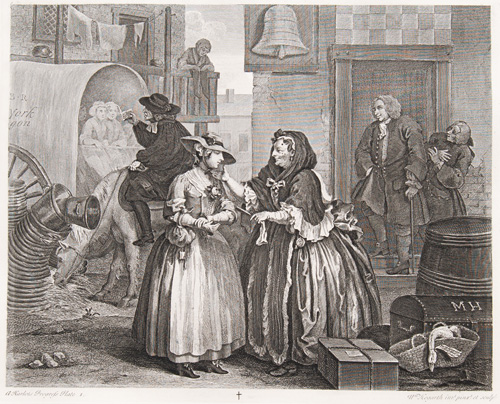
(click image to enlarge)
A Harlot's Progress
Plate 1
Invented, Painted and Engraved by William Hogarth
(Heath edition, 1822)
Sheet size: approx. 25 1/4 inches x 19 1/4 inches
Plate size: approx.
15 1/2 x 12 1/2 inches
An original copperplate engraving, over 200 years old.
Condition: Very Good to Excellent— very light foxing in margins, which would be covered once mounted/matted for framing. Minor edge/corner wear and/or handling.
Please see enlargement for more detail.
A nice dark, deep impression from one of Hogarth's most famous series!
[For sale in a complete set of 6, see below for details]
PLATE I
Before the Bell Inn in Wood Street, Mary or Moll Hackabout, newly arrived in London, is caught between the aggressive agents of corruption, who are set against the crumbling tavern wall, and the ordinary (and passive) middle-class people arranged around the solidly built home. Dressed in modestly designed clothes and bearing the scissors and pin cushion of a dressmaker, she has just alighted from the York wagon. Though she appears as fresh and artless as the rose that covers her bosom, her expression suggests that she is a little flattered by the attention of the bawd.
Above Moll, a housewife, surrounded by chamber pots and laundry, hangs out clothing. She seems to represent the secure if unexciting bourgeois life the girl leaves behind. With his back to her an affluent clergyman, perhaps Moll's father reads the address on a letter, probably a request to the Bishop of London for a sinecure ("To the Right Reverend Father in London"). Short-sighted and insensitive to the crises around him (including his own), like his horse, he is intent on fulfilling his personal ambitions and desires at the expense of his flock.
A bawd feels Moll with her naked hand in the same clinical way animals are inspected before purchase. This figures is said to resemble Mother Needham, the keeper of a notorious brothel patronized by the aristocracy; she had recently been stoned to death by the London populace when she was pilloried for managing a disorderly house. This procuress seems to be the instrument of the nobleman who stands in the shadow of the door leering intensely at the girl, his right hand fumbling suspiciously in his pocket. A symbol of aristocratic corruption, he has come with his pimp to prey on indigent, naïve young girls who alight here from the country. The nobleman has been identified as Colonel Charteris, the worst of the exploitative privileged class to which he belonged.
The coffin-like trunk with Moll's initials, the preoccupied clergyman (motifs which reappear in the final scenes) and the dead goose ("For my Lofing Cosen in Tems Stret in London") give a funereal and ominous cast to the scene.
|
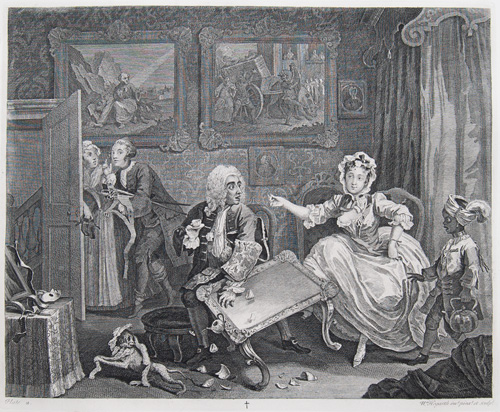
(click image to enlarge— Darvill's electronic watermark does not appear on actual engraving)
A Harlot's Progress
Plate 2
Invented, Painted and Engraved by William Hogarth
(Heath edition, 1822)
Sheet size: approx. 25 1/4 inches x 19 1/4 inches
Plate size: approx. 15 1/2 x 12 1/2 inches
An original copperplate engraving, over 200 years old.
Condition: Very Good to Excellent— very light foxing in margins, which would be covered once mounted/matted for framing. A smudge at bottom edge, well away from image. Minor edge/corner wear and/or handling.
Please see enlargement for more detail.
A nice dark, deep impression from one of Hogarth's most famous series!
[For sale in a complete set of 6, see below for details]
PLATE II
Seduced by the glitter of a life of wealth and comfort, Mill has fallen quickly from the hands of the procuress and nobleman into the keeping of an unattractive but wealthy Jewish businessman. Quite transformed by her experience, she apes the life style of the class to which she aspires; instead of her modest work clothes she wears silk stockings, stylish shoes and a fashionable dress that reveals her arms and breast. Her face, which bears a look of spirited insolence, is adorned with a beauty spot that may hide the first signs of venereal disease.
Her apartment is richly appointed. She keeps a maid (dressed much as she herself was in Plate I), an exotic West Indian servant boy and a monkey. The monkey, the most pointed indication of her affectation, resembles the merchant in facial expression and posture, and there is little difference in her treatment of either plaything. Prominent on her dressing table is a mirror, symbol of vanity, beside it a jar of make-up and a smiling white mask. The mask, which is not unlike a death mask, suggests that Moll has been taken to a masquerade by her partially but fashionably dressed visitor, a fellow noticeably more youthful and attractive than the middle-aged businessman who supports her.
Behind her hang small portraits of two contemporaries held to be atheists, Samuel Clarke and Thomas Woolaston. Above the whole scene are two large paintings, one of Jonah outside Nineveh seated next to an ivy plant, the other of David dancing before the Ark while Uzzah, attempting to touch it, is knifed in the back. The picture of Jonah may be a warning to heed the prophet's message to reform. The painting of David and Uzzah, one of whom is killed for his sacrilege, the other rebuked by his wife for indecency, seems to foreshadow the fates that await the two characters in the scene.
|
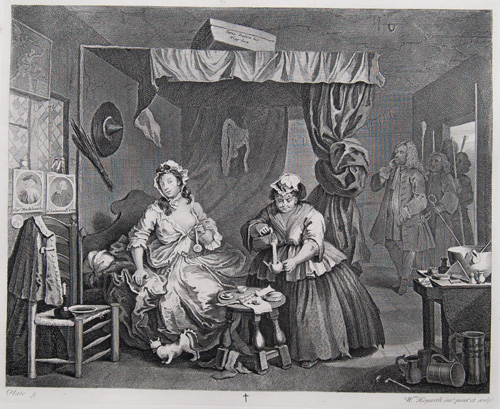
(click image to enlarge)
A Harlot's Progress
Plate 3
Invented, Painted and Engraved by William Hogarth
(Heath edition, 1822)
Sheet size: approx. 25 1/4 inches x 19 1/4 inches
Plate size: approx. 15 1/2 x 12 1/2 inches
An original copperplate engraving, over 200 years old.
Condition: Very Good to Excellent— 1-inch tear right edge, well away from image area. Minor edge/corner wear and/or handling.
Please see enlargement for more detail.
A nice dark, deep impression from one of Hogarth's most famous series!
[For sale in a complete set of 6, see below for details]
PLATE III
Discarded by the merchant and her marketability reduced by disease, Moll is forced to live in a slum in Drury Lane and serve the population at large, even sexual deviants. Her principal lover is now a highwayman, James Dalton; his wig box rests on top of her crudely arranged canopy. In this breakfast scene, which exactly parallels the previous one, Moll rises at 11:45 A.M. to take her morning tea. Dressed a little less flamoyantly and looking considerably less vivacious, she dangles a watch taken from the previous night's customer.
An ugly but practiced woman whose nose has been eaten away by disease has replaced her naïve servants. The bunter seems intended to serve as an example of the fate of those superannuated harlots who survive the mortal effects of syphilis. Moll's bed, only partially visible in a discreet corner of her former apartment, now fills the room. The delicate silver teapot is replaced by a tin pot and the elegant table by a heavy, functional piece on which lie butter wrapped in a pastoral letter ("Pastoral Letter to") and some eating utensils. her crude vanity holds a jar of professional make-up, a broken piece of mirror, a gin bottle, a fine-comb, a chipped punchbowl, a broken stem glass and a liquor measure. A letter addressed "To Md. Hackabout" lies in the vanity drawer. Beneath the table are ale measures and tobacco pipes.
The exotic monkey is replaced by a household cat that postures suggestively to indicate the girl's occupation. The large, expensively framed pictures of the previous apartment are here reduced to four small works. Above her chair (which holds her work coat, a candle and a dish—used as a chamber pot) is a medallion of some saint. Above that hangs portraits of mill's idos, the roguish highwayman Mac(k)heath from Gay's Beggar's Opera and "Dr Sacheveral S.T.P." (sanctae theologiae professor), a controversial divine of the period. Placed purposefully on top of these two portraits are a jar and two vials of "cures" for veneral disease.
Above the room's broken windows hangs a cheap print portraying an angel stopping Abraham from sacrificing Isaac; it seems to warn of the girl's impending and uninterceded fate at the hands of the law. Over Moll's bed hangs a witch's hat and a bundle of birch rods, suggesting that her condition requires her to engage in flagellation and black magic. A wig hangs on the drape behind her bed. Through her apartment door come an arresting magistrate and his constables to apprehend Moll for prostitution. The leading figure, who fondles his moustache effetely, has been identified as Sir John Gonson, a type of the perennial harlot-prosecutors whose righteousness is only equaled by their compulsiveness.
|
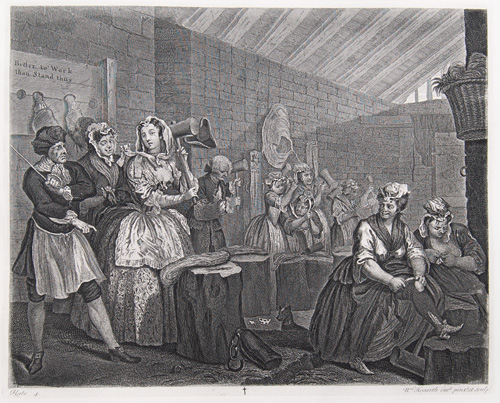
(click image to enlarge)
A Harlot's Progress
Plate 4
Invented, Painted and Engraved by William Hogarth
(Heath edition, 1822)
Sheet size: approx. 25 1/4 inches x 19 1/4 inches
Plate size: approx. 15 1/2 x 12 1/2 inches
An original copperplate engraving, over 200 years old.
Condition: Very Good to Excellent—very clean, minor edge/corner wear and/or handling.
Please see enlargement for more detail.
A nice dark, deep impression from one of Hogarth's most famous series!
[For sale in a complete set of 6, see below for details]
PLATE IV
Sentenced to Bridewell Prison, Moll beats hemp with the other prisoners, mostly women, in this brutalizing house of "correction." The spirited look is gone from her tired, flabby face and her mouth droops slightly. She lifts her mallet only with great effort. Dressed in a grand gown, she is an object of ridicule to those around her. At her side stands a stern-faced jailer who threatens her with the leg-iron and cane—the stocks are already filled by another inmate.
The prison itself is a nurturer of crime; behind Moll a woman (perhaps the keeper's wife) steals an item of the girl's dress while she mocks her fashionable condition and acquired sensibilities. Moll's servant, dressed in rags but for a pair of incongruously gaudy shoes and stockings, smiles at the woman's treatment of her mistress. Beside the servant, a woman kills vermin on her body.
The prisoners are ranked by the warden according to their wealth and appearance. Next to Moll stands an older, well-dressed man who has been permitted to bring his dog to jail with him; the forged playing card that lies in front of him has betrayed him. Next to him stands a mere child with a look of resignation on her pretty face; she works with great earnestness and intensity. Beside her a more experienced, older woman rests on her mallet as she watches the keeper's movements. The last visible figure in the line is a pregnant Black, evidence that women of all races are subject to the same fates. At the end of the shed is a crude vengeful stick drawing of Sir John Gonson hanging from the gallows; the letters "sr J G." appear above it. On the left wall stands a whipping post with the warning "The Wages of Idleness."
|
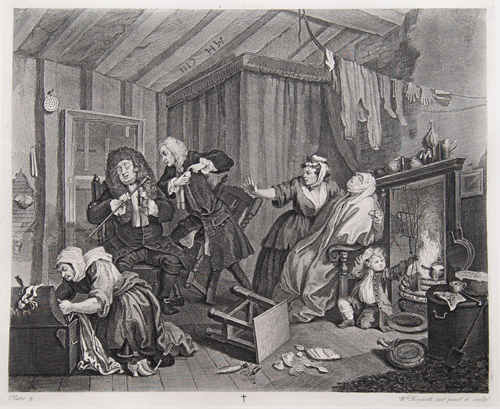
(click image to enlarge)
A Harlot's Progress
Plate 5
Invented, Painted and Engraved by William Hogarth
(Heath edition, 1822)
Sheet size: approx. 25 1/4 inches x 19 1/4 inches
Plate size: approx. 15 1/2 x 12 1/2 inches
An original copperplate engraving, over 200 years old.
Condition: Very Good to Excellent—very clean, minor edge/corner wear and/or handling.
Please see enlargement for more detail.
A nice dark, deep impression from one of Hogarth's most famous series!
[For sale in a complete set of 6, see below for details]
PLATE V
Moll is dying of venereal disease; already her face is white and waxen and her head falls lifelessly backward.The scene around her is agitated and disordered. Two expensively dressed parasites (identified as Dr. Richard Rock and Dr. Jean Misaubin) quarrel violently over the efficacy of their cures as their patient-victim expires unattended in their view. Before Moll's corpse is cold, a strange woman (perhaps the landlady) rifles her trunk. She has already selected for herself the most ominous articles of Moll's wardrobe: her witch's hat, her dancing shoes and her mask (now a black death mask) with a fan stuck grotesquely through its eyes. Moll's maid, with one comforting arm around the dying girl, attempts to stop the looting and the turmoil. The girl's son sits beside his mother, oblivious to her death, struggling with the lice in his hair and attempting to cook for himself.
The small apartment is the poorest and most primitive of Moll's abodes. Plaster has fallen from the walls; coal is stacked to the right of the fireside next to the bedpan covered with the plate ("B...Cook at the ..."); holes in the door have been filled in to keep the place warm. The room is without any of the signs of Moll's personality that characterize her previous apartments. Instead of works of art there hang on the wall only a broken mirror and a fly trap (a Jewish Passover cake coated with a sticky substance.)
Nor are there any of the usual signs of liquor; all her money has been spent on quack cures for her disease. On the floor, by the overturned table, lies an advertisement for and "anodyne" (pain-killing) necklace purchased to cure her own or perhaps her son's congenital syphilis. The mantelpiece is lined with similarly useless prescriptions. By the pipe, spittoon and old punchbowl, lie Moll's teeth; loosened by the fruitless use of mercury as a cure of venereal disease, they have come out. Over the expiriring figure of Moll hang the limp, ghostly forms of her laundry.
|
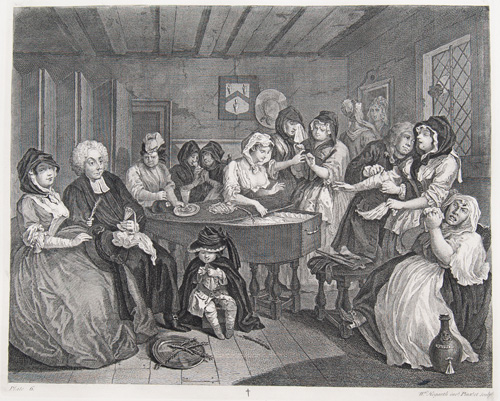
(click image to enlarge— Darvill's electronic watermark does not appear on actual engraving)
A Harlot's Progress
Plate 6
Invented, Painted and Engraved by William Hogarth
(Heath edition, 1822)
Sheet size: approx. 25 1/4 inches x 19 1/4 inches
Plate size: approx. 15 1/2 x 12 1/2 inches
An original copperplate engraving, over 200 years old.
Condition: Very Good to Excellent—very clean, minor edge/corner wear and/or handling.
Please see enlargement for more detail.
A nice dark, deep impression from one of Hogarth's most famous series!
[For sale in a complete set of 6, see below for details]
PLATE VI
Moll, dead at the age of twenty-three, is being waked. The plate on her coffin reads: "M. Hackabout Died Sepr 2d 1731 Aged 23." Nobody mourns her passing at the mock vigil held for her. Leading lives that are without options, her sisters have little to learn from her death. Gathered around her coffin, they exhibit a variety of contrasting attitudes toward the occasion. Their spiritual leader, the clergyman (identified by Hogarth as "the famous Couple-Beggar in The Fleet"), who is supposed to give a religious tone to the event, has his hand up the skirt of the girl beside him. his venereal preoccupation causes him to spill. The face of the girl who covers his exploring hand with a mourning hat is filled with a look of dreamy satisfaction.
Before the coffin Moll's son, decked out grandly as the principal mourner, plays with his spinning top. At the right side of the scene an old woman, probably Moll's bawd, howls in a fit of tears inspired as much by the brandy bottle at her side as by considerations of financial loss. Behind the bawd, an undertaker oversolicitously assists a girl with her glove; she postures as if in grief as she steals his handerkerchief. At the mirror a girl adjusts her headgear vainly, oblivious to the prominent disease spot on her forehead. A weeping figure shows a disordered finger to a companion who seems more curious than sympathetic.
Only one person lifts back the coffin lid (which is being used as a bar) to look in detached curiosity, rather than in grief or reflection, upon Moll's corpse. In the background two older women huddle together demonstratively and drink. The only person with a sense of decorum is Moll's maid, who glares angrily at the conduct of the parson and his mate. Above the scene stands a plaque showing three faucets with spigots in them, the ironic coat of arms of the company.
|
A Harlot's Progress
Original Copperplate Engravings and Etchings from:
The Works of William Hogarth from the Original Plates Restored by James Heath, Esq., R.A.; With the Addition of Many Subjects Not Before Collected: To Which is Prefixed, a Biographical Essay on the Genius and Productions of Hogarth, and Explanations on the Subjects of the Plates by John Nichols, Esq., F.S.A.
London: Printed for Baldwin, Cradock & Joy, Paternoster Row
by Nichols and Son, Parliament Street
— 1822 —
Complete set of 6 full-page, original copperplate engravings
— nearly 200 years old.

Please note: the shipping charge for these plates may need to be adjusted to account for a higher insurance value.
If necessary, we will send you a secure electronic invoice for the additional amount. Please be sure to check your email. Thank you.
|
|
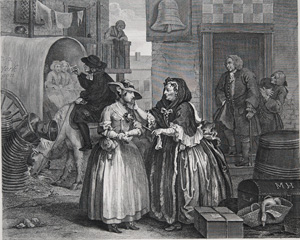
(click image to enlarge)
A Harlot's Progress
Plate 1
Invented, Painted and Engraved by William Hogarth
(Heath edition, 1822)
Sheet size: approx. 25 1/4 inches x 19 1/4 inches
Plate size: approx.
15 1/2 x 12 1/2 inches
An original copperplate engraving, over 200 years old.
Condition: Very Good to Excellent— Scattered foxing in margins, which would be covered once mounted/matted for framing.
Please see enlargement for more detail.
A nice dark, deep impression from one of Hogarth's most famous series!
[For sale in a complete set of 6, see below for details]
PLATE I
Before the Bell Inn in Wood Street, Mary or Moll Hackabout, newly arrived in London, is caught between the aggressive agents of corruption, who are set against the crumbling tavern wall, and the ordinary (and passive) middle-class people arranged around the solidly built home. Dressed in modestly designed clothes and bearing the scissors and pin cushion of a dressmaker, she has just alighted from the York wagon. Though she appears as fresh and artless as the rose that covers her bosom, her expression suggests that she is a little flattered by the attention of the bawd.
Above Moll, a housewife, surrounded by chamber pots and laundry, hangs out clothing. She seems to represent the secure if unexciting bourgeois life the girl leaves behind. With his back to her an affluent clergyman, perhaps Moll's father reads the address on a letter, probably a request to the Bishop of London for a sinecure ("To the Right Reverend Father in London"). Short-sighted and insensitive to the crises around him (including his own), like his horse, he is intent on fulfilling his personal ambitions and desires at the expense of his flock.
A bawd feels Moll with her naked hand in the same clinical way animals are inspected before purchase. This figures is said to resemble Mother Needham, the keeper of a notorious brothel patronized by the aristocracy; she had recently been stoned to death by the London populace when she was pilloried for managing a disorderly house. This procuress seems to be the instrument of the nobleman who stands in the shadow of the door leering intensely at the girl, his right hand fumbling suspiciously in his pocket. A symbol of aristocratic corruption, he has come with his pimp to prey on indigent, naïve young girls who alight here from the country. The nobleman has been identified as Colonel Charteris, the worst of the exploitative privileged class to which he belonged.
The coffin-like trunk with Moll's initials, the preoccupied clergyman (motifs which reappear in the final scenes) and the dead goose ("For my Lofing Cosen in Tems Stret in London") give a funereal and ominous cast to the scene.
|
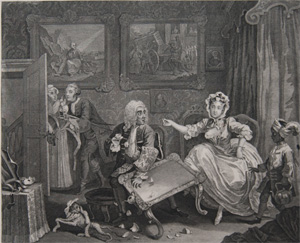
(click image to enlarge— Darvill's electronic watermark does not appear on actual engraving)
A Harlot's Progress
Plate 2
Invented, Painted and Engraved by William Hogarth
(Heath edition, 1822)
Sheet size: approx. 25 1/4 inches x 19 1/4 inches
Plate size: approx. 15 1/2 x 12 1/2 inches
An original copperplate engraving, over 200 years old.
Condition: Very Good to Excellent— Scattered foxing in margins, which would be covered once mounted/matted for framing.
Please see enlargement for more detail.
A nice dark, deep impression from one of Hogarth's most famous series!
[For sale in a complete set of 6, see below for details]
PLATE II
Seduced by the glitter of a life of wealth and comfort, Mill has fallen quickly from the hands of the procuress and nobleman into the keeping of an unattractive but wealthy Jewish businessman. Quite transformed by her experience, she apes the life style of the class to which she aspires; instead of her modest work clothes she wears silk stockings, stylish shoes and a fashionable dress that reveals her arms and breast. Her face, which bears a look of spirited insolence, is adorned with a beauty spot that may hide the first signs of venereal disease.
Her apartment is richly appointed. She keeps a maid (dressed much as she herself was in Plate I), an exotic West Indian servant boy and a monkey. The monkey, the most pointed indication of her affectation, resembles the merchant in facial expression and posture, and there is little difference in her treatment of either plaything. Prominent on her dressing table is a mirror, symbol of vanity, beside it a jar of make-up and a smiling white mask. The mask, which is not unlike a death mask, suggests that Moll has been taken to a masquerade by her partially but fashionably dressed visitor, a fellow noticeably more youthful and attractive than the middle-aged businessman who supports her.
Behind her hang small portraits of two contemporaries held to be atheists, Samuel Clarke and Thomas Woolaston. Above the whole scene are two large paintings, one of Jonah outside Nineveh seated next to an ivy plant, the other of David dancing before the Ark while Uzzah, attempting to touch it, is knifed in the back. The picture of Jonah may be a warning to heed the prophet's message to reform. The painting of David and Uzzah, one of whom is killed for his sacrilege, the other rebuked by his wife for indecency, seems to foreshadow the fates that await the two characters in the scene.
|
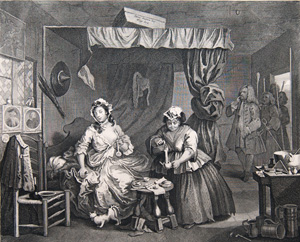
(click image to enlarge)
A Harlot's Progress
Plate 3
Invented, Painted and Engraved by William Hogarth
(Heath edition, 1822)
Sheet size: approx. 25 1/4 inches x 19 1/4 inches
Plate size: approx. 15 1/2 x 12 1/2 inches
An original copperplate engraving, over 200 years old.
Condition: Very Good to Excellent— Scattered foxing in margins, which would be covered once mounted/matted for framing.
Please see enlargement for more detail.
A nice dark, deep impression from one of Hogarth's most famous series!
[For sale in a complete set of 6, see below for details]
PLATE III
Discarded by the merchant and her marketability reduced by disease, Moll is forced to live in a slum in Drury Lane and serve the population at large, even sexual deviants. Her principal lover is now a highwayman, James Dalton; his wig box rests on top of her crudely arranged canopy. In this breakfast scene, which exactly parallels the previous one, Moll rises at 11:45 A.M. to take her morning tea. Dressed a little less flamoyantly and looking considerably less vivacious, she dangles a watch taken from the previous night's customer.
An ugly but practiced woman whose nose has been eaten away by disease has replaced her naïve servants. The bunter seems intended to serve as an example of the fate of those superannuated harlots who survive the mortal effects of syphilis. Moll's bed, only partially visible in a discreet corner of her former apartment, now fills the room. The delicate silver teapot is replaced by a tin pot and the elegant table by a heavy, functional piece on which lie butter wrapped in a pastoral letter ("Pastoral Letter to") and some eating utensils. her crude vanity holds a jar of professional make-up, a broken piece of mirror, a gin bottle, a fine-comb, a chipped punchbowl, a broken stem glass and a liquor measure. A letter addressed "To Md. Hackabout" lies in the vanity drawer. Beneath the table are ale measures and tobacco pipes.
The exotic monkey is replaced by a household cat that postures suggestively to indicate the girl's occupation. The large, expensively framed pictures of the previous apartment are here reduced to four small works. Above her chair (which holds her work coat, a candle and a dish—used as a chamber pot) is a medallion of some saint. Above that hangs portraits of mill's idos, the roguish highwayman Mac(k)heath from Gay's Beggar's Opera and "Dr Sacheveral S.T.P." (sanctae theologiae professor), a controversial divine of the period. Placed purposefully on top of these two portraits are a jar and two vials of "cures" for veneral disease.
Above the room's broken windows hangs a cheap print portraying an angel stopping Abraham from sacrificing Isaac; it seems to warn of the girl's impending and uninterceded fate at the hands of the law. Over Moll's bed hangs a witch's hat and a bundle of birch rods, suggesting that her condition requires her to engage in flagellation and black magic. A wig hangs on the drape behind her bed. Through her apartment door come an arresting magistrate and his constables to apprehend Moll for prostitution. The leading figure, who fondles his moustache effetely, has been identified as Sir John Gonson, a type of the perennial harlot-prosecutors whose righteousness is only equaled by their compulsiveness.
|
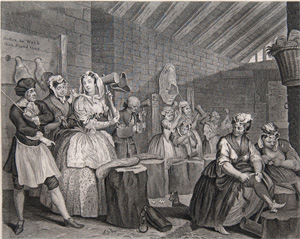
(click image to enlarge)
A Harlot's Progress
Plate 4
Invented, Painted and Engraved by William Hogarth
(Heath edition, 1822)
Sheet size: approx. 25 1/4 inches x 19 1/4 inches
Plate size: approx. 15 1/2 x 12 1/2 inches
An original copperplate engraving, over 200 years old.
Condition: Very Good to Excellent— Scattered foxing in margins, which would be covered once mounted/matted for framing.
Please see enlargement for more detail.
A nice dark, deep impression from one of Hogarth's most famous series!
[For sale in a complete set of 6, see below for details]
PLATE IV
Sentenced to Bridewell Prison, Moll beats hemp with the other prisoners, mostly women, in this brutalizing house of "correction." The spirited look is gone from her tired, flabby face and her mouth droops slightly. She lifts her mallet only with great effort. Dressed in a grand gown, she is an object of ridicule to those around her. At her side stands a stern-faced jailer who threatens her with the leg-iron and cane—the stocks are already filled by another inmate.
The prison itself is a nurturer of crime; behind Moll a woman (perhaps the keeper's wife) steals an item of the girl's dress while she mocks her fashionable condition and acquired sensibilities. Moll's servant, dressed in rags but for a pair of incongruously gaudy shoes and stockings, smiles at the woman's treatment of her mistress. Beside the servant, a woman kills vermin on her body.
The prisoners are ranked by the warden according to their wealth and appearance. Next to Moll stands an older, well-dressed man who has been permitted to bring his dog to jail with him; the forged playing card that lies in front of him has betrayed him. Next to him stands a mere child with a look of resignation on her pretty face; she works with great earnestness and intensity. Beside her a more experienced, older woman rests on her mallet as she watches the keeper's movements. The last visible figure in the line is a pregnant Black, evidence that women of all races are subject to the same fates. At the end of the shed is a crude vengeful stick drawing of Sir John Gonson hanging from the gallows; the letters "sr J G." appear above it. On the left wall stands a whipping post with the warning "The Wages of Idleness."
|
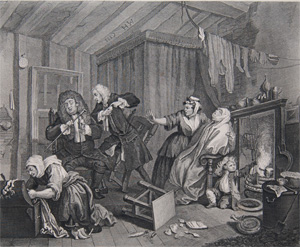
(click image to enlarge)
A Harlot's Progress
Plate 5
Invented, Painted and Engraved by William Hogarth
(Heath edition, 1822)
Sheet size: approx. 25 1/4 inches x 19 1/4 inches
Plate size: approx. 15 1/2 x 12 1/2 inches
An original copperplate engraving, over 200 years old.
Condition: Very Good to Excellent— Scattered foxing in margins, which would be covered once mounted/matted for framing.
Please see enlargement for more detail.
A nice dark, deep impression from one of Hogarth's most famous series!
[For sale in a complete set of 6, see below for details]
PLATE V
Moll is dying of venereal disease; already her face is white and waxen and her head falls lifelessly backward.The scene around her is agitated and disordered. Two expensively dressed parasites (identified as Dr. Richard Rock and Dr. Jean Misaubin) quarrel violently over the efficacy of their cures as their patient-victim expires unattended in their view. Before Moll's corpse is cold, a strange woman (perhaps the landlady) rifles her trunk. She has already selected for herself the most ominous articles of Moll's wardrobe: her witch's hat, her dancing shoes and her mask (now a black death mask) with a fan stuck grotesquely through its eyes. Moll's maid, with one comforting arm around the dying girl, attempts to stop the looting and the turmoil. The girl's son sits beside his mother, oblivious to her death, struggling with the lice in his hair and attempting to cook for himself.
The small apartment is the poorest and most primitive of Moll's abodes. Plaster has fallen from the walls; coal is stacked to the right of the fireside next to the bedpan covered with the plate ("B...Cook at the ..."); holes in the door have been filled in to keep the place warm. The room is without any of the signs of Moll's personality that characterize her previous apartments. Instead of works of art there hang on the wall only a broken mirror and a fly trap (a Jewish Passover cake coated with a sticky substance.)
Nor are there any of the usual signs of liquor; all her money has been spent on quack cures for her disease. On the floor, by the overturned table, lies an advertisement for and "anodyne" (pain-killing) necklace purchased to cure her own or perhaps her son's congenital syphilis. The mantelpiece is lined with similarly useless prescriptions. By the pipe, spittoon and old punchbowl, lie Moll's teeth; loosened by the fruitless use of mercury as a cure of venereal disease, they have come out. Over the expiriring figure of Moll hang the limp, ghostly forms of her laundry.
|
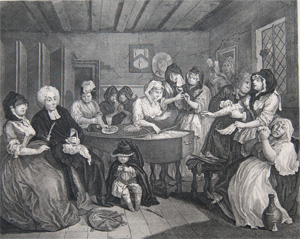
(click image to enlarge— Darvill's electronic watermark does not appear on actual engraving)
A Harlot's Progress
Plate 6
Invented, Painted and Engraved by William Hogarth
(Heath edition, 1822)
Sheet size: approx. 25 1/4 inches x 19 1/4 inches
Plate size: approx. 15 1/2 x 12 1/2 inches
An original copperplate engraving, over 200 years old.
Condition: Very Good to Excellent— Scattered foxing in margins, which would be covered once mounted/matted for framing.
Please see enlargement for more detail.
A nice dark, deep impression from one of Hogarth's most famous series!
[For sale in a complete set of 6, see below for details]
PLATE VI
Moll, dead at the age of twenty-three, is being waked. The plate on her coffin reads: "M. Hackabout Died Sepr 2d 1731 Aged 23." Nobody mourns her passing at the mock vigil held for her. Leading lives that are without options, her sisters have little to learn from her death. Gathered around her coffin, they exhibit a variety of contrasting attitudes toward the occasion. Their spiritual leader, the clergyman (identified by Hogarth as "the famous Couple-Beggar in The Fleet"), who is supposed to give a religious tone to the event, has his hand up the skirt of the girl beside him. his venereal preoccupation causes him to spill. The face of the girl who covers his exploring hand with a mourning hat is filled with a look of dreamy satisfaction.
Before the coffin Moll's son, decked out grandly as the principal mourner, plays with his spinning top. At the right side of the scene an old woman, probably Moll's bawd, howls in a fit of tears inspired as much by the brandy bottle at her side as by considerations of financial loss. Behind the bawd, an undertaker oversolicitously assists a girl with her glove; she postures as if in grief as she steals his handerkerchief. At the mirror a girl adjusts her headgear vainly, oblivious to the prominent disease spot on her forehead. A weeping figure shows a disordered finger to a companion who seems more curious than sympathetic.
Only one person lifts back the coffin lid (which is being used as a bar) to look in detached curiosity, rather than in grief or reflection, upon Moll's corpse. In the background two older women huddle together demonstratively and drink. The only person with a sense of decorum is Moll's maid, who glares angrily at the conduct of the parson and his mate. Above the scene stands a plaque showing three faucets with spigots in them, the ironic coat of arms of the company.
|
A Harlot's Progress
Original Copperplate Engravings and Etchings from:
The Works of William Hogarth from the Original Plates Restored by James Heath, Esq., R.A.; With the Addition of Many Subjects Not Before Collected: To Which is Prefixed, a Biographical Essay on the Genius and Productions of Hogarth, and Explanations on the Subjects of the Plates by John Nichols, Esq., F.S.A.
London: Printed for Baldwin, Cradock & Joy, Paternoster Row
by Nichols and Son, Parliament Street
— 1822 —

to Mr G. E.
Complete set of 6 full-page, original copperplate engravings
— over 200 years old.
Please note: the shipping charge for these plates may need to be adjusted to account for a higher insurance value.
If necessary, we will send you a secure electronic invoice for the additional amount. Please be sure to check your email. Thank you.
|
| |
INDIVIDUAL PLATES FROM HEATH EDITION (1822) |
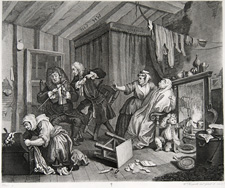
(click image to enlarge)
"A Harlot's Progress, Plate 5"
(Heath edition, 1820-22)
Sheet size: approx. 25 1/4 inches x 18 3/4 inches
Plate size: approx. 15 1/2 x 12 3/4 inches
Condition: Very good; very minor foxing in margins, age toning at edges, repaired tear to lower left edge
$499.95
|
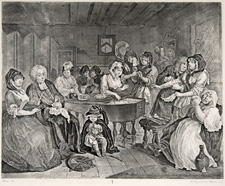
(click image to enlarge) "A Harlot's Progress, Plate 6"
(Heath edition, 1820-22)
Sheet size: approx. 25 1/4 inches x 18 3/4 inches
Plate size: approx. 15 1/4 x 12 1/2 inches
Condition: Very good to Fine; very minor foxing in margins, age toning at edges, minor bumping and edgewear, staple hole upper right edge $579.95 |
"The Works of William Hogarth" by Rev. John Trusler
published by Jones and Co, London (1833) |
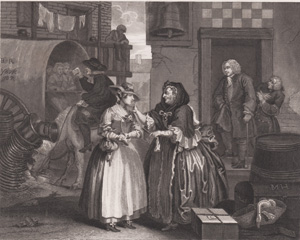
(click image to enlarge)
The Harlot's Progress
(Plate 1)
Ensnared by a Procuress
"The Works of William Hogarth
in a Series of Engravings: with descriptions and a
Comment on Their Moral Tendency
by the Rev. John Trusler"
(Jones and Co., Temple of the Muses, (Late Lackington's), Finsbury Square, London, 1833)
Original 180+-year-old copperplate engraving
Sheet size: 8 1/4 x 10 1/2 inches
original text accompanies engraving
Condition: Very Good/Excellent. Minor spotting in margin.
Please see detailed scan by clicking on above thumbnail image.
AVAILABLE AS A COMPLETE SET, SEE BELOW
|
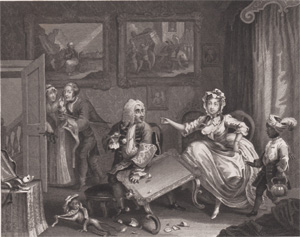
(click image to enlarge)
The Harlot's Progress
(Plate 2)
Quarrels with her Jew Protector
"The Works of William Hogarth
in a Series of Engravings: with descriptions and a
Comment on Their Moral Tendency
by the Rev. John Trusler"
(Jones and Co., Temple of the Muses, (Late Lackington's), Finsbury Square, London, 1833)
Original 180+-year-old copperplate engraving
Sheet size: 8 1/4 x 10 1/2 inches
original text accompanies engraving
Condition: Very Good/Excellent
Please see detailed scan by clicking on above thumbnail image.
AVAILABLE AS A COMPLETE SET, SEE BELOW
|
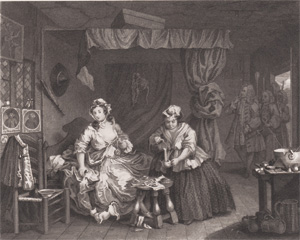
(click image to enlarge)
The Harlot's Progress
(Plate 3)
Apprehended by a Magistrate
"The Works of William Hogarth
in a Series of Engravings: with descriptions and a
Comment on Their Moral Tendency
by the Rev. John Trusler"
(Jones and Co., Temple of the Muses, (Late Lackington's), Finsbury Square, London, 1833)
Original 180+-year-old copperplate engraving
Sheet size: 8 1/4 x 10 1/2 inches
original text accompanies engraving
Condition: Very Good/Excellent
Please see detailed scan by clicking on above thumbnail image.
AVAILABLE AS A COMPLETE SET, SEE BELOW
|
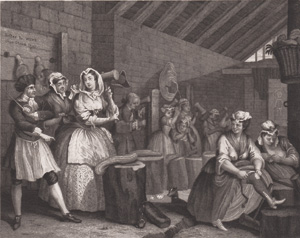
(click image to enlarge)
The Harlot's Progress
(Plate 4)
Scene in Bridewell
"The Works of William Hogarth
in a Series of Engravings: with descriptions and a
Comment on Their Moral Tendency
by the Rev. John Trusler"
(Jones and Co., Temple of the Muses, (Late Lackington's), Finsbury Square, London, 1833)
Original 180+-year-old copperplate engraving
Sheet size: 8 1/4 x 10 1/2 inches
original text accompanies engraving
Condition: Very Good/Excellent
Please see detailed scan by clicking on above thumbnail image.
AVAILABLE AS A COMPLETE SET, SEE BELOW
|
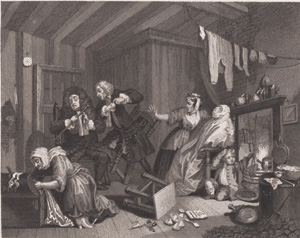
(click image to enlarge)
The Harlot's Progress
(Plate 5)
Expires while the Doctors are Disputing
"The Works of William Hogarth
in a Series of Engravings: with descriptions and a
Comment on Their Moral Tendency
by the Rev. John Trusler"
(Jones and Co., Temple of the Muses, (Late Lackington's), Finsbury Square, London, 1833)
Original 180+-year-old copperplate engraving
Sheet size: 8 1/4 x 10 1/2 inches
original text accompanies engraving
Condition: Very Good/Excellent
Please see detailed scan by clicking on above thumbnail image.
AVAILABLE AS A COMPLETE SET, SEE BELOW
|
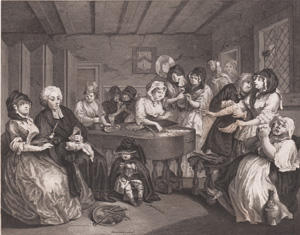
(click image to enlarge)
The Harlot's Progress
(Plate 6)
The Funeral
"The Works of William Hogarth
in a Series of Engravings: with descriptions and a
Comment on Their Moral Tendency
by the Rev. John Trusler"
(Jones and Co., Temple of the Muses, (Late Lackington's), Finsbury Square, London, 1833)
Original 180+-year-old copperplate engraving
Sheet size: 8 1/4 x 10 1/2 inches
original text accompanies engraving
Condition: Fair, some foxing in image
Please see detailed scan by clicking on above thumbnail image.
AVAILABLE AS A COMPLETE SET, SEE BELOW
|
SET OF 6 "The HARLOT'S PROGRESS" COPPERPLATE ENGRAVINGS FROM
The Works of William Hogarth
(Trusler, 1833)

|